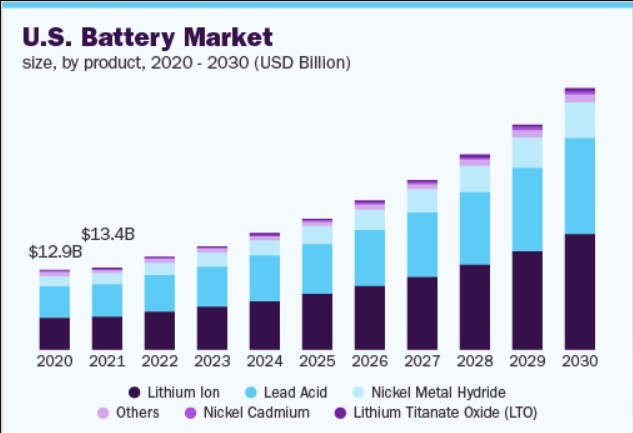Revolutionizing the Future: Battery Technology and Market Trends Transforming Industries

In the heart of the digital age, where connectivity and mobility intersect, battery technology emerges as a silent yet powerful force shaping our world. Every innovation from the sleek smartphones in our pockets to the electric vehicles swiftly cruising our highways, and even the renewable energy systems powering homes and businesses, relies profoundly on advances in battery technology. These seemingly mundane components are, in fact, key enablers of our sustainable future, making every leap in their development a leap towards a more efficient and cleaner world.
As we stand on the brink of transformative shifts in energy usage and transportation, the importance of evolving battery technologies cannot be overstressed. They are the linchpins in the global effort to reduce carbon footprints and combat climate change. In energy storage, batteries provide the crucial buffer that allows solar and wind power to deliver electricity reliably, even when the sun sets or the wind ceases. For electric vehicles, they are the heartbeat, where improvements in battery capacity and charging speed directly translate to enhanced usability and broader adoption. In the realm of portable electronics, battery advancements promise to extend device longevity, reduce waste, and enhance user experience.
By embracing the pivotal role that battery technology plays across various sectors, we can unlock new potentials and drive forward the innovations necessary for a sustainable future. This article delves into both the cutting-edge advancements and the burgeoning market trends that are setting the pace for this dynamic field’s future.
Existing Battery technologies and their Limitations
The landscape of battery technology, as it stands today, is dominated by a few key types that power our daily lives and industrial applications. Foremost among these is the lithium-ion battery, celebrated for its high energy density and efficiency. It powers everything from mobile phones and laptops to electric vehicles and large-scale energy storage systems. Nickel-Metal Hydride (NiMH) batteries, while somewhat overshadowed by the capabilities of lithium-ion, still find widespread use in hybrid cars, medical devices, and rechargeable household items due to their robustness and cost-effectiveness.
Despite their ubiquity, these technologies are not without limitations. Lithium-ion batteries, for instance, face challenges such as long charging times and degradation over cycles, which can significantly affect performance and longevity. Safety concerns also persist, as they are prone to overheating and can pose fire hazards under certain conditions. The environmental impact is non-trivial; the mining of lithium, cobalt, and other minerals essential for these batteries raises substantial ecological and ethical concerns.
NiMH batteries, although less susceptible to safety issues, suffer from a lower energy density and a higher self-discharge rate when compared to lithium-ion solutions. This makes them less ideal for the energy demands of more intensive modern applications. Both battery types face the ongoing challenge of improving energy capacity, extending lifespan, and reducing environmental impact through more sustainable practices and materials. Addressing these challenges is crucial as the demand for efficient, reliable, and eco-friendly energy storage solutions continues to grow.

Breakthroughs in Battery Technology
As we navigate the evolving landscape of battery technology, several breakthroughs are poised to redefine the standards of power storage and delivery. One of the most anticipated developments is the solid-state battery, which promises to overhaul the traditional lithium-ion batteries currently prevalent in most applications. Unlike conventional batteries that use a liquid electrolyte, solid-state batteries utilize a solid electrolyte. This fundamental change in design offers a multitude of advantages, such as significantly higher energy density, which translates to longer battery life and the ability to store more power in a smaller package.
Moreover, solid-state batteries are inherently safer. The absence of a liquid electrolyte eliminates the risk of leakage and reduces the likelihood of fire hazards associated with overheating. This makes them particularly attractive for use in electric vehicles and other applications where safety is paramount. Additionally, these batteries exhibit less degradation over time, potentially offering a longer lifespan than their liquid counterparts, which suffer from rapid capacity loss with repeated charge-discharge cycles.
Beyond solid-state technology, other innovative battery types are also emerging. Lithium-sulfur batteries, for example, are gaining attention due to their higher energy density compared to lithium-ion batteries. They use sulfur as a cathode material, which is both more abundant and cheaper than the cobalt used in many lithium-ion batteries. However, challenges such as short cycle life and poor conductivity need to be addressed before lithium-sulfur can enter mainstream markets.
Graphene batteries also represent a cutting-edge development, leveraging the remarkable properties of graphene — a form of carbon that is incredibly strong, light, and an excellent conductor of electricity. Graphene batteries can potentially charge much faster than lithium-ion batteries and may also hold more energy, which could revolutionize energy storage across multiple industries, including mobile devices and electric vehicles.
These breakthroughs illustrate a dynamic and rapidly advancing field of battery technology that holds the promise to drive significant advancements in everything from consumer electronics to grid storage and transportation, shaping a more efficient and sustainable future.

Solid-State Batteries
Fundamental Design Change: Utilizes a solid electrolyte instead of the traditional liquid electrolyte.
Advantages:
- Higher Energy Density: Enables longer battery life and more power storage in a smaller package.
- Increased Safety: No risk of leakage and reduced fire hazards, making it ideal for electric vehicles and safety-critical applications.
- Longer Lifespan: Exhibits less degradation over time compared to liquid electrolyte batteries.
Lithium-Sulfur Batteries
Key Features:
- Higher Energy Density: Offers greater storage capacity than current lithium-ion batteries.
- Cost-Effective Material: Uses sulfur as the cathode material, which is more abundant and cheaper than cobalt.
Challenges:
- Cycle Life: Currently suffers from a short cycle life which limits its usability.
- Conductivity Issues: Poor conductivity needs to be improved for commercial viability.
Graphene Batteries
Utilizing Graphene: Employs graphene, known for its exceptional strength, lightness, and conductivity.
- Potential Benefits:
- Rapid Charging: Can charge significantly faster than traditional lithium-ion batteries.
- Higher Capacity: Potentially holds more energy, which could transform energy storage in various industries.
Applications: Promising for use in mobile devices, electric vehicles, and more.
Impact and Future Prospects
- These emerging technologies promise to transform the landscape of energy storage, offering more efficient, safer, and cost-effective solutions.
- The advancements in battery technology are pivotal for the future of consumer electronics, electric mobility, and renewable energy integration.

Market Trends: Driving Battery Innovation
The relentless drive for innovation in battery technology is not merely a pursuit of scientific advancement but a response to distinct market trends that demand increasingly sophisticated solutions. These trends, spanning from electric vehicles (EVs) to renewable energy systems and consumer electronics, collectively push the boundaries of what batteries can achieve.
Electric Vehicles (EVs)
- Rising EV Adoption: The global shift towards electric vehicles, driven by environmental concerns and supportive policies, has created a surge in demand for advanced batteries.
- Development Focus: Manufacturers are intensively developing batteries that offer longer ranges and faster charging capabilities to address range anxiety and improve user convenience.
- Technological Response: This demand has accelerated investment in technologies such as solid-state batteries and improved lithium-ion formulations that enhance energy density and reduce charging times.
Renewable Energy Storage
- Integration Challenges: As the world increasingly turns to renewable sources like solar and wind, the intermittent nature of these sources presents unique challenges.
- Role of Batteries: Batteries are crucial for stabilizing these energy sources, ensuring that the power supply remains constant regardless of weather conditions.
- Expansion of Utility-Scale Storage: There is significant growth in the deployment of utility-scale battery storage systems, which are essential for managing energy loads and providing backup during peak times.
Consumer Electronics
- Evolving Device Needs: The consumer electronics market demands batteries that are not only compact but also more powerful and longer-lasting, driven by devices that are increasingly energy-intensive and multifunctional.
- Innovation Trigger: This demand has spurred innovations aimed at packing more energy into smaller spaces without compromising safety and efficiency.
- Durability and Efficiency: Manufacturers are focused on developing batteries that charge faster, last longer, and are more durable, aligning with the lifestyle needs of modern consumers.
These market trends are not isolated but interconnected, influencing and enhancing each other across industries. As each sector evolves, it catalyzes further innovations in battery technology, creating a cycle of advancement that continually reshapes the energy landscape.
Conclusion:
Battery technology stands as the linchpin of future technological and sustainable advancements, as discussed. Its pivotal role in powering electric vehicles, renewable energy storage, and portable electronics cannot be overstated. The need for further research, investment, and regulatory support is paramount to drive the development of advanced battery solutions. By doing so, we can accelerate the transition towards a cleaner, more efficient energy landscape while reducing reliance on fossil fuels. It’s imperative that stakeholders across industries collaborate to innovate and implement these technologies, ushering in a future of enhanced efficiency and reduced environmental impact. Let’s seize this opportunity to shape a more sustainable world through the advancement of battery technology.

